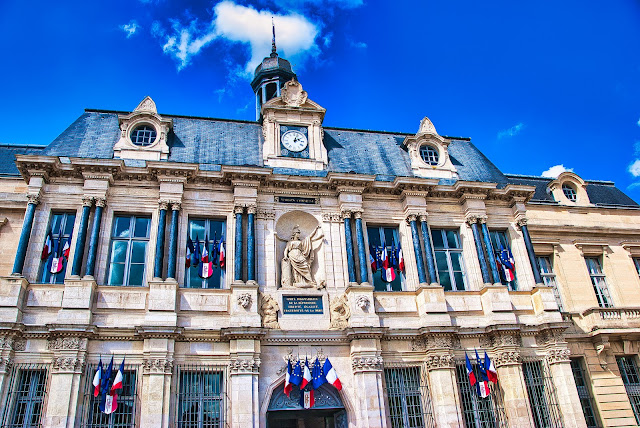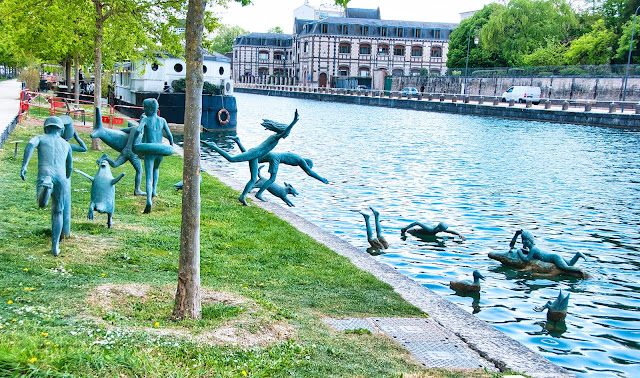We are scheduled for a night in Dinant, Belgium, and arrived in late afternoon. It’s a beautiful little town on the river. This area, including parts of Belgium and France were the scene of some of the most bloody fighting in World War I. As we drove toward the town, we passed through many place names we recognized from our history courses long ago
We stayed in an old Abbey perched high above the river. Well, it sounded idyllic when we booked it. I rapidly found reasons to be less than charmed. Our “suite“ reached only by a tiny, creaky, elevator (phobia number two and number three). Luckily, we were only booked for a night and the next morning we approached our car with anticipation of reaching France and the Château Beauchamp.
 o o |
| Deirdre looking out at the Meuse River from the bridge, with the Church and buildings in the background. |
 |
| A picture of the hotel where we stayed, which was formerly the Abbaye Notre-Dame de Leffe. Beer was first brewed here in 1240, as a means of protecting the citizens from tainted water. Dinant is divided by the Meuse River and the town is on both sides of the river connected by a bridge. |
 |
| Adolphe Sax, who was born in Dinant, invented the saxophone. In tribute to Adolphe different, large, colored saxophones representing different countries were arranged on the bridge. This saxophone was representing Croatia. |
 |
| This saxophone was representing the USA. These saxophones have lined the bridge since 2010. |
 |
| You can see the various saxophones extending along the bridge, and they were on both sides. |
 |
| We always find the different architecture in each place interesting and notable. |
 |
| This also holds true for the different architectural styles of the churches. The Collegiate Church, with its distinctive onion dome dates from the 16th century. |
 |
| In the background behind these buildings was the Citadel of Dinant constructed in 1815, which was involved in the Battle of Dinant in World War I. The bridge across the Meuse is named in honor of Charles de Gaulle, who was a young lieutenant and was wounded in the leg during the battle. |
 |
| These, letters strung between the two buildings, translate to "At the end of the street", encouraging the Belgians to go to the end of the street. |
And thus begins the saga of the demonically possessed car. We have leased cars in the past and always received a brand new, reliable and economically, sound vehicle. That was all over. We got into the car and Michael tried to start it. Nothing. No whirring. No clunking. Nothing. We made our first call (many to follow) to the 800 number 24 hour assistance line. We explained our problem to someone who, sort of, spoke English. They said they would dispatch someone to help us, and after two more calls in an hour, a man arrived in a tow truck. He jumped the car and pronounced our problem solved. We pointed out that the car was brand new, we had driven it hundreds of miles over several days, and it shouldn’t do this. He gave a gallic shrug and said he’d follow us down the incredibly steep hill into town. This was considerate since our dashboard warning system was saying that our brakes didn’t work. We decided his diagnosis was not sufficient. So, we went to a Renault dealer to get the car checked out. At the first dealer, we were politely turned away since one mechanic had called in sick and the second was on a smoking break. Yes, a smoking break. They directed us to a second Renault dealer and after I asked in my pathetic French that we needed help, they agreed to look at the car. They hooked up the computer diagnostic machine (the only way anything seems to get attention) and pronounced “Zee auto is fine“. We didn’t think so, but pushed on.
We arrived at our Château in one piece, but fearing each time we turned the car off that it would never start again. By now we were deep in the countryside with no Renault dealer in sight.
We loved our new dwelling. where we would spend six nights. My brother, Stephen and my sister-in-law Lee would be arriving by train in Dijon the next day around noon to join us. We zoomed into Dijon and fetched them with no problem. However, upon returning to the car once again, our dashboard warning lights were lit up urging us to attend to a low battery level. Damn! We have to get to another Renault dealer where I was forced to plead even more pitifully for immediate attention. They were very solicitous and spent 2 1/2 hours scouring the car to find the problem only to announce “there is no problem with Zee ka”. OK, fine.
The time with our kin folks passed quickly. We went to several small towns in Champagne on our first day and tucked into one of our better meals in Chaumont. Michael woke up in the middle of the night unable to sleep and sought out some other fun place to explore. And he hit pay dirt.The place he found was named TROYES but is pronounced TROIS.” Go figure. This dissimilarity between how a town is written and how it is pronounced is quite common in France. We had been to a town called UZES three times before we discovered how to say it correctly. Troyes was magnificent. Almost all the houses were timber framed, and it was a delight to stroll the narrow (sometimes very narrow) alleys and streets. Some of the houses were being restored, and we were pleased to see that they were adhering to the same architectural style of the original town.
 |
| Lee and Steve making their way through the Allée des Chats (Alley of Cats) in Troyes, which is called this because it is so narrow the cats can jump from one building to the other. |
 |
| Steve and Deirdre in Troyes. |
 |
| One of the many half-timbered houses in Troyes, which date back to the 16th century and evokes its rich Medieval and Renaissance past when the large Champagne Fairs were held here. |
 |
| Some more examples of the half-timbered houses. |
 |
| This half-timbered house was the local synagogue and displayed the menorah and the Star of David on the grills covering the windows. |
 |
| This was the entrance to the synagogue Rachi. |
 |
| A woman peering from the window of her half-timbered house. |
 |
| There were many amazing sculptures throughout Troyes, this being an example of two of them. |
 |
| This very cute little girl decided to pose in front of one of them. |
 |
The flowering trees showed that Spring had definitely arrived in Troyes.
|
"The saying goes that France is home to 80% of the world's stained glass, that 80% of French stained glass windows north of the Loire are in the Champagne region, and that 80% of the stained glass windows in the Champagne region are in the Aube départment." (Troyes La Champagne Tourisme). The Aube contains approximately 9,000 square meters of stained glass windows. o
o













































As always, great to read. Dee, you look just the same in your picture with Steve. We just came back from Venice. No car stories, but we needed help sometimes getting in and out of the gondolas!
ReplyDelete